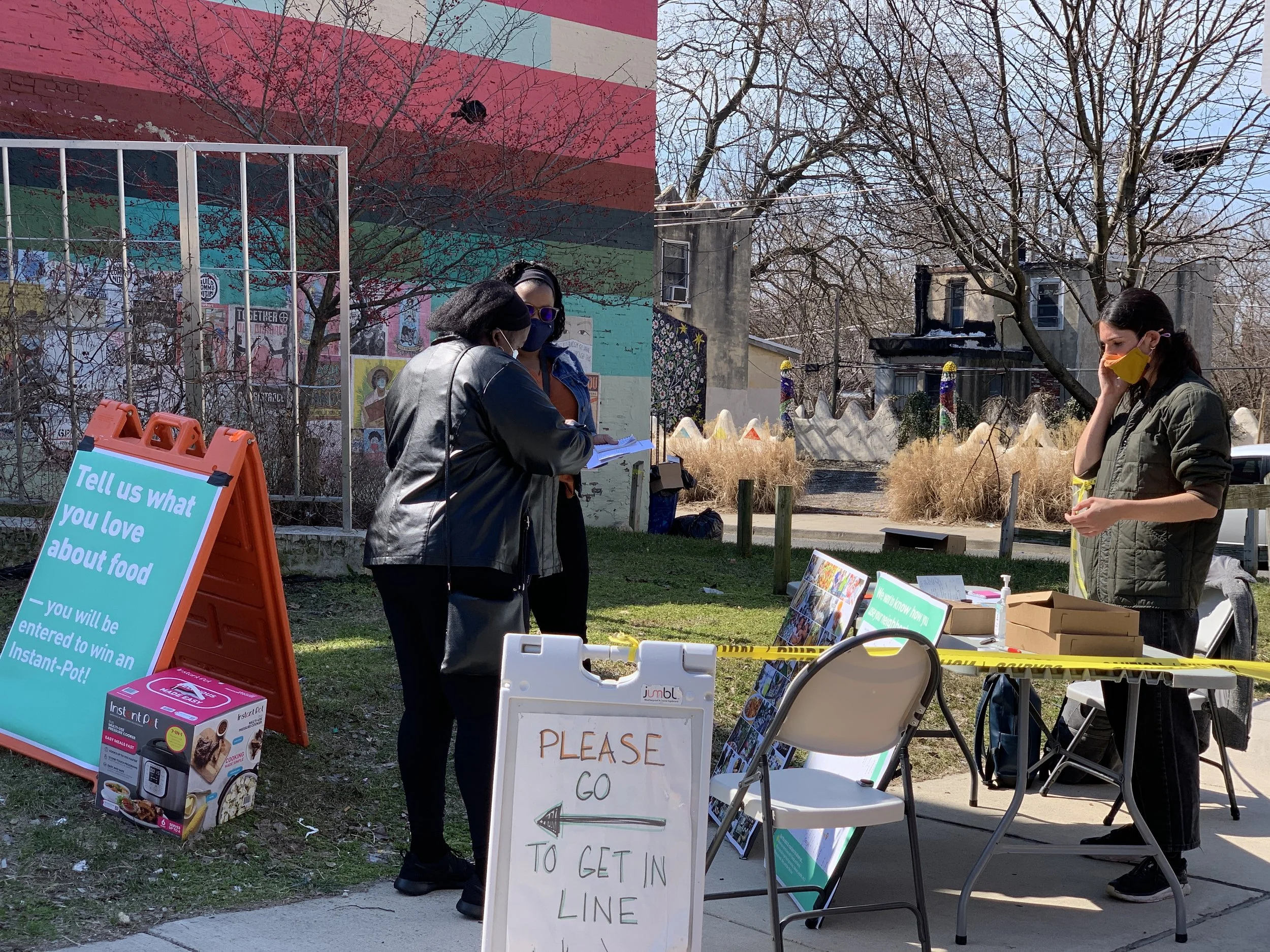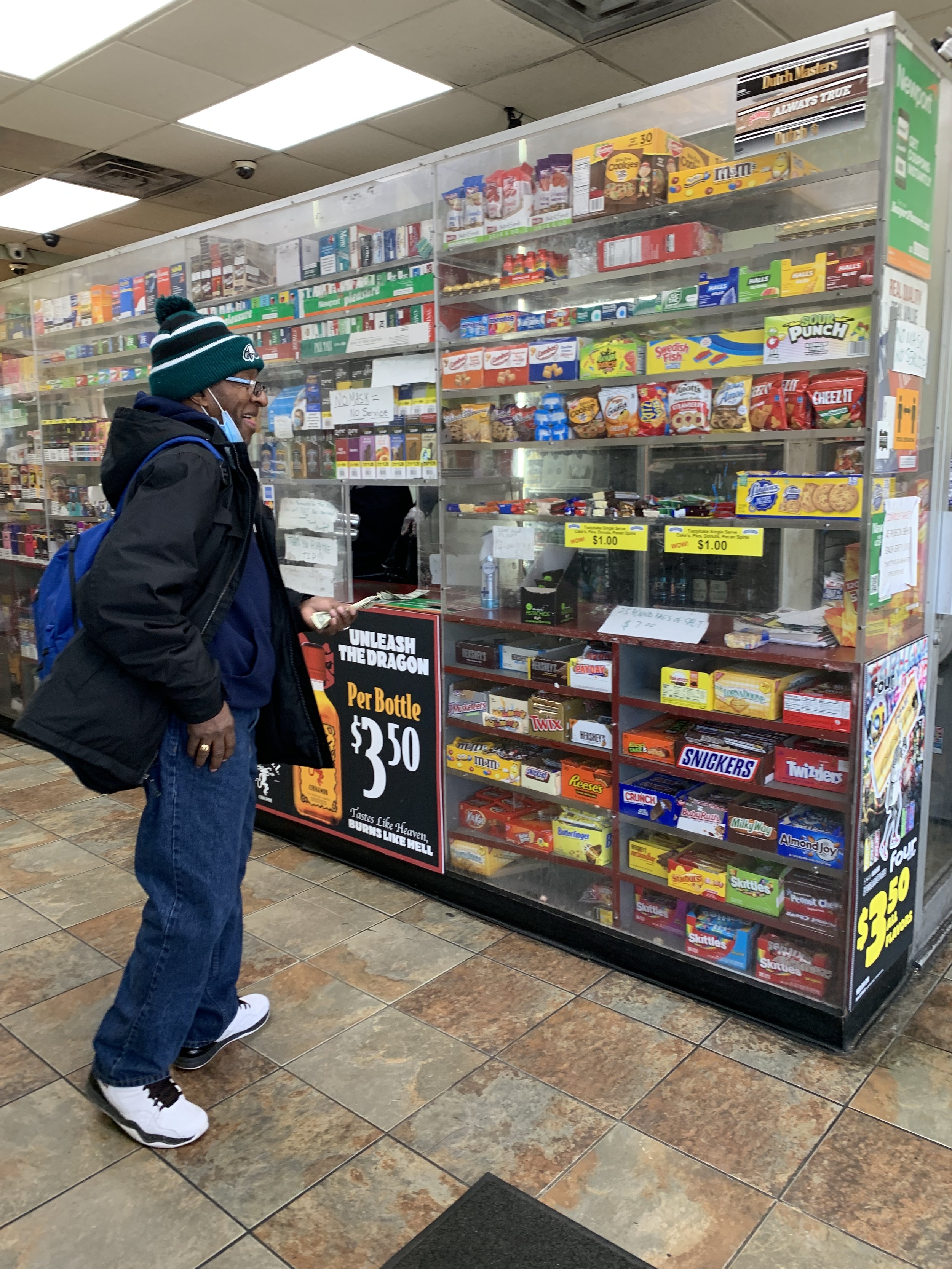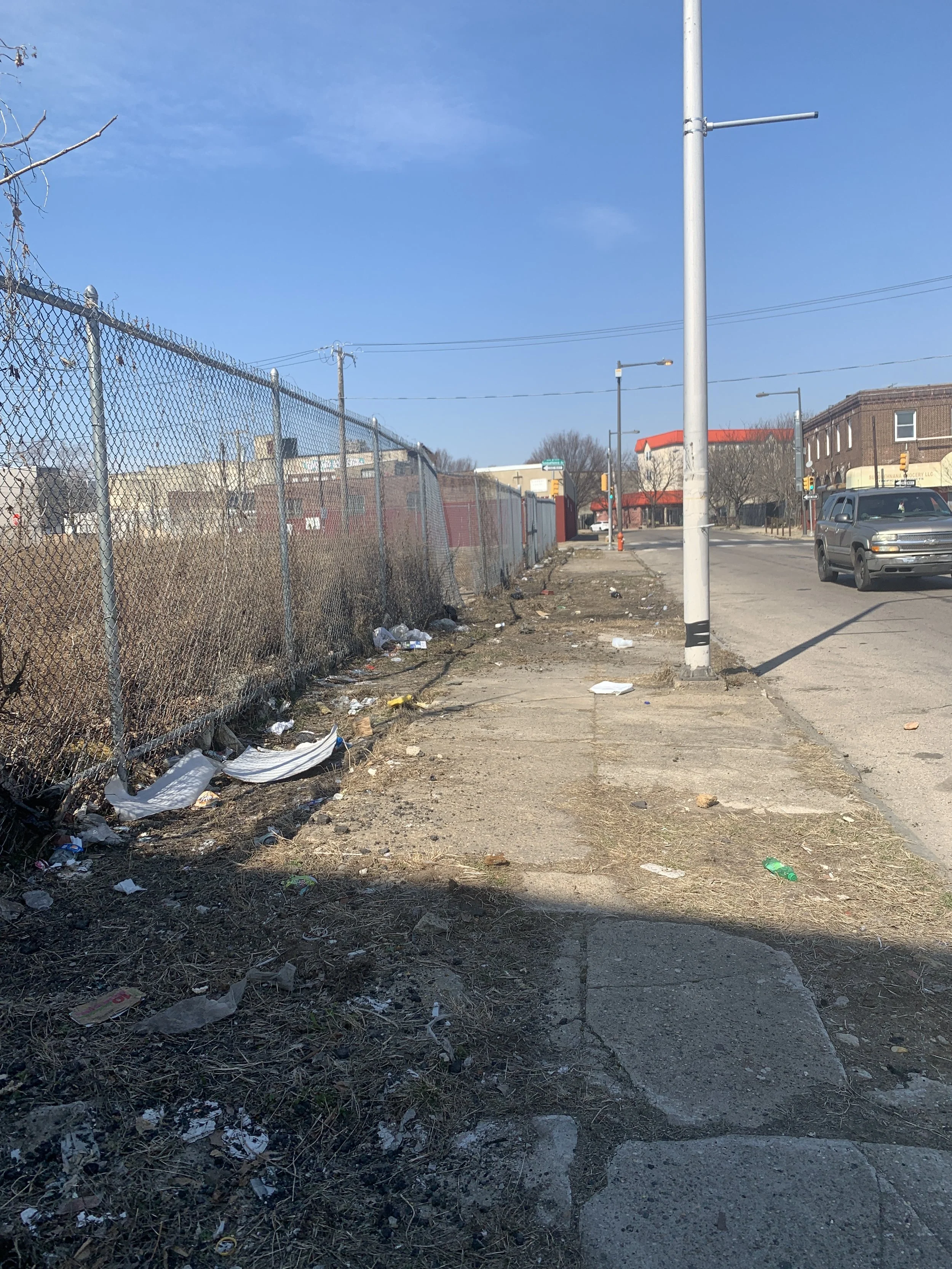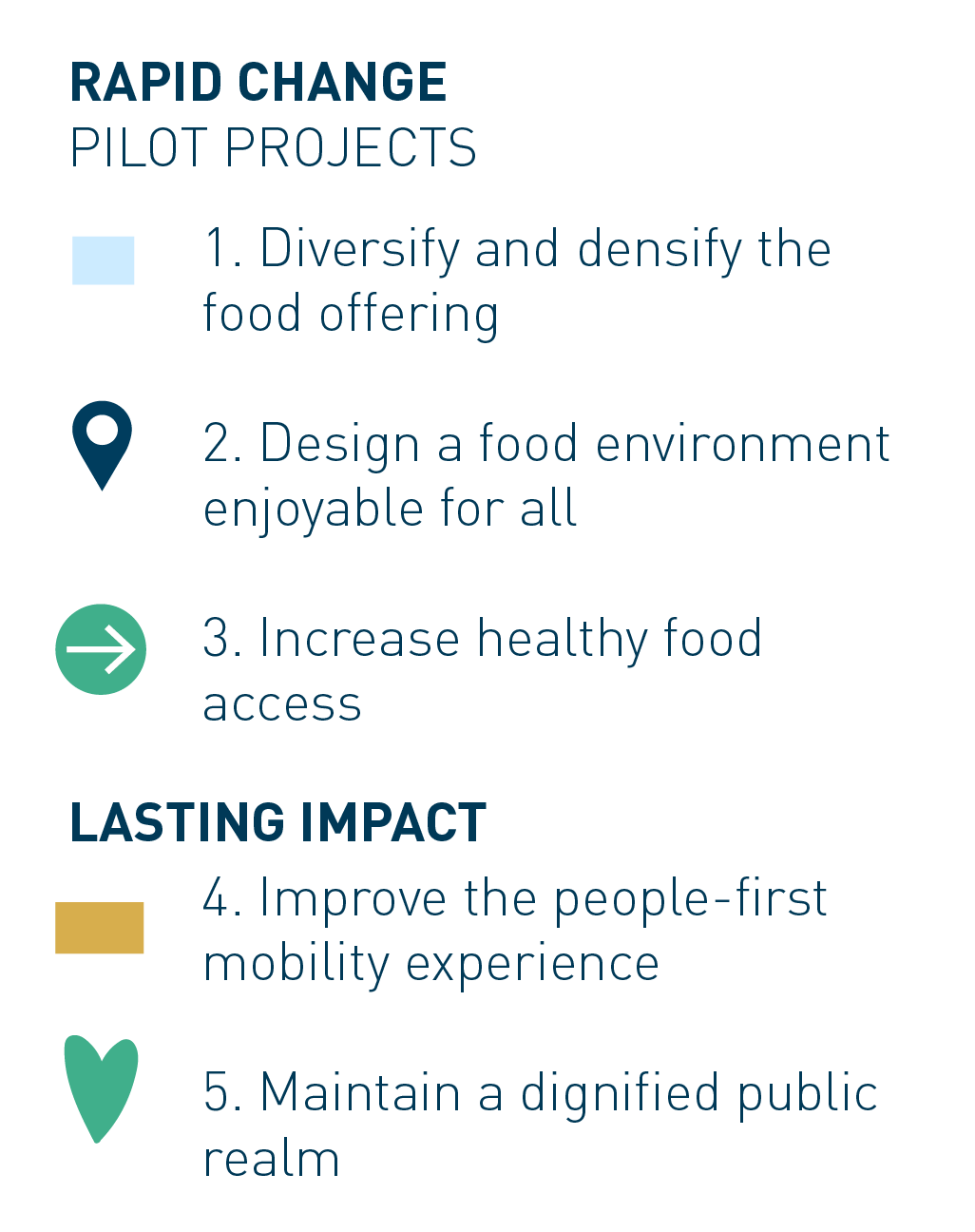
Change happens at the speed of trust: expanding food access in north philadelphia
City: Philadelphia, USA
Year: 2020 — 2023
Status: Completed
Local partners: Philabundance, Village of Arts and Humanities.
The Philabundance Community Kitchen is located in North Philadelphia, in the neighbourhood of Hartranft.
Gehl and Philabundance, a regional food bank in the US, led a Foodscapes Assessment in Philadelphia to drive a strategy to create sustainable food security in an underserved neighborhood. The work included a Foodscapes Assessment, a Healthy Neighbourhood Strategy, and three pilot project ideas to create equitable and joyful experiences around accessing healthy food.
The Challenge
Expanding food access for North Philadelphia residents
In 2020, Philabundance launched a program to create sustainable food security in Hartranft, Pennsylvania, a neighbourhood that suffers from long-time disinvestment. To support this program, Gehl and Philabundance teamed up to better understand community needs related to food and urban design near Philabundance’s Community Kitchen.
Quick facts
Research and study context
Food insecurity caused by long-term systemic disinvestment
North Philadelphia has historically experienced systemic food insecurity, inefficient food distribution systems, shrinking social programs, and disinvestment in the public realm and affordable housing. Forty five percent of residents live below the poverty line and 22% are food insecure.
Most community members identify as Black or African American. Hartranft grapples with economic and social issues created by systemic racism and racial segregation in US cities; these have resulted in a reality that on average, Black Americans have lower income levels and lower educational attainment than other racial groups, and are more likely to endure high levels of violence in their neighbourhoods. Black neighbourhoods are also more likely to lack the resources that support physical activity, healthy nutrition, and quality housing conditions, which is associated with a higher risk of diabetes.
With this local and national context in mind, the team undertook the task of understanding the lived experience of the Harntanft community in an effort to build trust and better meet their needs.
Many residents in North Philadelphia rely on the emergency food distribution system. Grocery stores are located at the outskirts of the neighbourhood.
Gehl attended a food box giveaway at the Village of Arts and Humanities to have conversations with residents about how they get their food, what kinds of foods they love, and the food experiences they cherish.
Foodscape assessment
Research methodology
The Gehl and Philabundance team anchored foodscapes research on two overarching project goals:
Identify how the relationship between the food system and the urban environment influences people’s everyday eating habits
Create strategies and interventions to achieve a positive dietary shift and improve access to healthy food
The team used a mix of qualitative and quantitative research methods. The project kicked off during the Covid-19 epidemic, and due to restrictions in in-person meeting began to explore local perspectives with an initial online survey. This proved ineffective, with few responses: a combination of a digital divide, lack of trust, and lack of time meant that answering questions online for an unknown reason from an organisation that had not yet built trust was not a priority for the community.
At that moment the team pivoted from seeking broad quantitative data to getting deep, qualitative data through individual conversations. This approach could also build trust locally. Gehl and Philabundance first met with two community leaders who walked the team around the neighbourhood and described food access challenges, where people hang out, and why they spend their time there. The team then hosted a pop-up engagement at a food distribution event, asking questions to gain an understanding of the qualities that people value when it comes to cooking, eating, and sharing food. For more information on these methods, see the drop downs to the right.
These experiences exemplify a key truth about working in underserved communities: it is important to start engagement slowly and prioritise active listening, to build trust and gain a comprehensive understanding of the community's lived experience and needs.
Methods used
-
By mapping the location and types of food places in the community, the research team gained an initial understanding of the foodscape. This method helped define which areas of the neighbourhood to study further at eye level as well as identify geographical food access gaps, public spaces, and transit services.
-
To get a broad, community-wide, quantitative impression of people's food behaviours, needs, and preferences, the team launched an online survey. However, the survey resulted in few responses, owing to a digital divide, lack of trust with the sponsoring organisation, and lack of free time to complete surveys.
-
Gehl and Philabundance were fortunate to connect with trusted community champions from local organizations: Moor Ali (Urban Creators) and Ro (Village of Arts and Humanities). Moor and Ro took the time to walk the team around Harntranft to tour popular public spaces, common routes taken through the neighbourhood, grocery spots, and local community gardens and other food spaces that had been co-created by community members. They also introduced the team to community members who were already working on food distribution. This walk changed everything: by connecting with local experts, the team was able to improve the engagement strategy to connect with the Harntranft community in ways that were convenient to them.
-
Through 1:1 conversations with local organisations and community champions in-person and over the phone, the team mapped out existing programs and social infrastructure that the assessment could help inform and build upon. The local organisations engaged were: Village of Arts and Humanities, Temple University, Asociación Puertorriqueños en Marcha (APM), Urban Creators, Temple student body, PCOM student body, Drexel Community HUB, No More Secrets, MBS Inc., City of Philadelphia, Greensgrow, Philly Food Trust, Bright Hope Baptist Church, Midtown Parish, Church of the advocate, Jones Memorial Church, Beckett Life Center, Caring People Alliance, Bicycle Coalition, and Mayfair BID.
-
The Village of Arts and Humanities hosted Gehl for a pop-up engagement during a fresh food box distribution event. The team set up a table at the event with some conversation-starting materials like an eye-catching poster advertising a raffle for a pressure cooker and a warm meal in exchange for local's time and input about their food experiences. The goal of the engagement was to get a better understanding of what people love to eat and what kinds of food experiences they cherish to spur ideas about how the neighbourhood foodscape could be improved.
-
The team hosted a series of workshops inviting representatives from local business groups, different city departments, and community representatives, holding a series of 10 unique 1:1 discussions with various key actors in Philadelphia. Organizations invited to the workshops included: Food TrustOffice of Transportation Infrastructure & Sustainability, Parks and Recreation, Philadelphia Health Management Corporation, PHMC, Mayor's Office, The City of Philadelphia, LISC, Willian Penn Foundation, Bank of America, Philadelphia Department of Public Health, Aktana, Episcopal Community Services, Philadelphia, Brewerytown Sharswood Community Civic Association (BSCCA, The Merchants Fund, North 10 Philadelphia, Drexel University Center for Food & Hospitality Management, Temple University, Nemours and the Philadelphia Housing Authority.
-
To better understand the day-to-day experience of accessing food and eating in the community, the team observed food places. This included observing people's behaviour – like where people eat, what kinds of things they eat, and how they transport groceries – as well as mapping the physical qualities of food places like what kinds of food they sell, what foods they advertise prominently, and how inviting they are to passers by.
-
The team sought the help of 22 volunteer community researchers to study 11 areas using Gehl's Public Space Public Life (PSPL) methodology. A PSPL provides empirical evidence and arguments for improving the public realm. The team counted people moving through Harntranft on different modes of transportation, mapped where and how they stayed, the activities they engaged in, and the demographics of people present or missing from the public realm. Data from the PSPL helped the team understand the lived eye-level experience of the neighbourhood.
Map of the food places in Hartranft. The red dots are food places on the Temple University campus, while the dark blue are located in Germantown and green on Broad Street. Light blue are supermarkets.
Click to enlarge.
Only 2% of all food places that are easily accessible to residents of North Philadelphia offer fresh fruits and vegetables.
Residents share a value of getting together to enjoy meals, but the neighbourhood doesn't provide public places to do so. All residents that we surveyed prefer to eat homemade food, and most like to enjoy it with others.
Lack of investment in pedestrian infrastructure greatly reduces the experience and safety of moving around in the neighbourhood.
Synthesis of key findings
Most food options are on the campus of Temple University, where many low-income residents don’t feel welcome
Through mapping food places, Gehl discovered that most local food options were located on the campus of Temple University – a place where some long-term residents felt unwelcome for a variety of reasons. Many Hartranft residents shared that Temple felt like an exclusive island of privilege in an otherwise disinvested neighbourhood.
This played out in local demographics as well as design: campus architecture was pristine and carefully maintained, in comparison to a surrounding neighbourhood with crumbling or non-existent sidewalks. The stark divide in physical investment, combined with higher than average prices on campus, made many residents see food options at Temple as a non option.
Where people live, there are few places that sell fresh produce, and options that do exist don't provide food for residents to thrive
Locals communicated a desire to buy healthy produce - but few such places exist in Hartranft today. Grocery stores are few, and only about 19% of residents are within walking distance from a grocery store in the neighbourhood. The emergency food system does offer fresh food, but locations are not necessarily placed at locations that are easy for all locals to access. Because of this, most people have no convenient option for food shopping besides corner stores and fast food restaurants.
By surveying shops in the neighbourhood, the team found that only 2% of all food places easily accessible to the community sell fresh fruits and vegetables. The study revealed that it is not feasible for corner stores to sell produce because of infrastructure and logistical challenges, such as lack of cold storage. In addition, shop owners believed that demand for fresh produce was insufficient, and feared the financial risk of unwanted food expiring or being stolen.
As a result, easily accessible food is typically highly processed, shelf-stable, and lacks nutritional value.
Places with food offerings have a low quality public realm and high quality places for recreation don't have food offerings
The study also indicated that many people want to eat communally with others: 63% of people prefer to eat with friends and family. However, the neighbourhood offers few quality opportunities for people to come together and enjoy food in public spaces. While there are some quality public spaces that invite families to spend time, such as Penrose Playground, these don’t offer a quality food options nearby. On the other hand, places that provide food, such as Broad and Susquehanna Streets, are not equipped with communal seating and comfortable spaces to eat in groups.
Disinvestment in the public realm reduces food accessibility
Fifty five percent of people walk or take the bus to buy their groceries, but the public realm poses many challenges to a comfortable journey. Physical obstacles, poorly maintained walking surfaces, and a lack of sidewalks are common. In addition, there is a lack of shade and shelter from the elements along people's routes to groceries. Public transit is unpredictable and underperforms with long headways, and bus stops have no places to sit or relax during the long wait.
As a result of the poor pedestrian experience, walking to the grocery store feels even longer than it actually is. When the team asked locals how long they thought it took to walk from transit to the supermarket, they believed (on average) that the journey took 23 minutes, when the actual walk was 18 minutes.
Strategic planning
Turning insights into strategies
By synthesizing key findings from the data, observations, and conversations, Gehl and Philabundance devised overarching strategies for designing a healthy Foodscape in Hartranft. The team then mapped these strategies to physical spaces in the neighbourhood based on areas of highest opportunity.
-
— Explore infrastructural and grant-making opportunities to promote the sale of fresh produce in corner stores and restaurants.
— Support local food businesses with small loans or grants to open in vacant spaces.
— Encourage Philabundance Community Kitchen students with entrepreneurship programs to start their own culinary businesses nearby.
— Implement a jobs program for youth to deliver groceries to those in need.
-
— Sync up emergency food system efforts and reduce redundancies through a shared platform and logistics network.
— Supplement grocery stores with a fleet of mobile grocery and prepared food vendors.
— Work with existing and new restaurants to develop a list of certified healthy dishes.
— Limit advertising for non-nutritious food items at corner stores.
-
— Improve the bus stop waiting experience with shelter, ample seating, and real-time arrival signage.
— Implement traffic calming along major roads and commercial streets to make movement between home and grocery stores easier and safer.
— Introduce a maintenance plan for crosswalks and sidewalks.
-
— Provide infrastructure to support outdoor grilling and dining in parks and public spaces.
— Consider multi-generational needs with comfortable seating, shade and vegetation, and play spaces.
— Bring healthy food options to where people already are in key public spaces.
-
— Place food amenities adjacent to other everyday destinations such as the metro, religious institutions, or community centres.
— Promote both real and perceived safety with a broad range of lighting and sidewalk improvements.
— Introduce a vegetation strategy to bring green elements into the community.
Strategies were mapped geographically to identify areas with best potential for impact.
Click to enlarge.
Pilot design
Three project ideas to test the strategy
To test and implement these strategies, Gehl developed pilot projects that built upon existing Philabundance programs. Pilot ideas included a mobile grocery store whose route is informed by public health and lived experience data; improvements to the neighbourhood’s favourite public space so people can eat communally outside together; and a small business incubation and loan program to lower the barrier to entrepreneurship for community members.
These pilot projects were guided by two simple strategies:
Improve the surrounding environment where people buy and eat food
Bring great nutritious food to where people spend the most time
Penrose Playground Food Court
Penrose Playground is a centre of public life in Harntranf. Recognizing this, the team designed a pilot to answer the community's desire to share meals together and upgrade an already beloved public space.
The pilot proposes to rewrite historic disinvestment by introducing furnishing, grills, basic cooking equipment, and a food truck selling nutritious, affordable meals. This pilot provides an opportunity to turn something good into something great by improving a park that people are already spending time in and creating an environment where people have the opportunity to make and share food with one another.
The Mobile Market
The Mobile Market pilot asks: What if instead of walking 25 minutes to the nearest supermarket, you could access all the ingredients needed for your evening meal from a truck easily accessible during your daily routines? Picture the reliability and joy of an ice cream truck, but for produce!
This pilot proposes to create a mobile grocery vendor that provides food from surrounding food distribution agencies, including prepared meals from the Philabundance Community Kitchen. The mobile grocery will travel a predetermined route informed by public health and lived experience data about where people spend time and where need is highest. The mobile grocer will travel to everyday destinations like schools, making it convenient to get fresh food.
Food Hub in a Box
This pilot explores how the Philabundance Community Kitchen’s existing educational curriculum could take the next step with a small business incubation and loan program. The intent is to lower the barrier to food entrepreneurship for community members.
Investment in the local community is two-fold: the project proposes to help local entrepreneurs get the support they need while also creating a safe community space and food option for the neighbourhood. The loan program will have certain requirements that incentivise healthy food and quality places to enjoy it. To access business support, a food offering must be nutritious and the atmosphere of the food place should be enjoyable for the community.
This is the first pilot to be implemented by Philabundance, and is currently in progress.
Impact assessment
The Foodscape Assessment helped Philabundance shift to a more human-centred service model
From community conversations to pilots, the Foodscape Assessment created a sea change at Philabundance by providing the perspective of a human, eye-level experience of healthy food access. Philabundance has continued to use the methods learned through this process to listen to community needs and make strides towards long term, community backed change, and in 2022 used the Thriving Foodscapes methods to study two more Philadelphia neighbourhoods: Strawberry Mansion and Sharswood.
Philabundance pivoted from using only quantitative metrics of services provided to measure success (like amount of food distributed) to also including qualitative data around neighbourhood wellbeing as the primary measure of the program's effectiveness. The organisation is committed to assessing ongoing community engagement to ensure quality engagement is at the core of their operations. New positions at Philabundance have been created to support this organisational shift to place community connection at the heart of the process.
There have been two key overarching results from this organisational shift:
New ongoing partnerships to build trust, empower communities, and make intentional investments. Building relationships with community partners has allowed Philabundance to better deliver impact and support sustainable food security efforts, in the following ways:
Developed strong relationships and formed a neighbourhood coalition.
Created a point of view for how Philabundance can best support and give power to the community.
Amplified community voices in Philabundance’s strategic planning.
Developed a reputation of trust that allowed Philabundance to expand.
Decentralised food access points and prioritised sustainable hunger relief over emergency food distribution. Understanding and building on existing community assets became the core of the Philabundance service model. This led to core changes in the way the organization works in the following ways:
Created a new model for food banking that centres building community trust, hiring a dedicated team to do so and expanding community engagement competencies within the organization.
Leveraged community resources as a way to decentralise food access and bring food closer to the people who need it.
Built out an entrepreneurship tract in programming for the Philabundance Community Kitchen.
Developed a home delivery service.
“This project changed the way that we work. The assessment allowed us to better serve our neighbours in need. We found the experience so rewarding that we plan to use Community Foodscape Assessments as a component of all our future place-based work”
— Jamiliyah Foster, former director of
Ending Hunger for Good / Philabundance
Want to learn more?
Check out our other case studies or explore the methods used.








